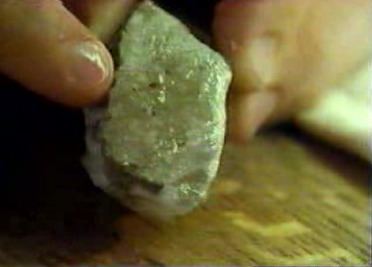 | ||
Shocked quartz is a form of quartz that has a microscopic structure that is different from normal quartz. Under intense pressure (but limited temperature), the crystalline structure of quartz is deformed along planes inside the crystal. These planes, which show up as lines under a microscope, are called planar deformation features (PDFs), or shock lamellae.
Contents
Discovery
Shocked quartz was discovered after underground nuclear bomb testing, which caused the intense pressures required to form it. Eugene Shoemaker showed that shocked quartz is also found inside craters created by meteor impact, such as the Barringer Crater and Chicxulub crater. The presence of shocked quartz proves that these craters were formed by an impact: a volcano would not generate the pressure required.
Prevalence
Shocked quartz is found worldwide, in the thin Cretaceous–Paleogene boundary layer, which occurs at the contact between Cretaceous and Paleogene rocks. This is further evidence (in addition to iridium enrichment) that the transition between the two geological periods was caused by a large impact. Though shocked quartz is only recently recognized, Eugene Shoemaker discovered it in building stones in the Bavarian town of Nördlingen.
Structure
Shocked quartz is associated with two high-pressure polymorphs of silicon dioxide: coesite and stishovite. These polymorphs have a crystal structure different from standard quartz. This structure can be formed only by intense pressure (more than 2 gigapascals), but at moderate temperatures. High temperatures would anneal the quartz back to its standard form. Coesite and stishovite are also indicative of impact events (or nuclear explosion).
